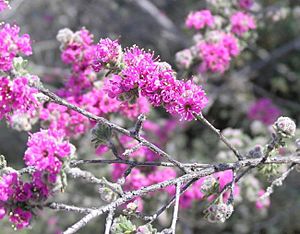Kunzea preissiana facts for kids
Quick facts for kids Kunzea preissiana |
|
|---|---|
 |
|
| Kunzea preissiana in the Fitzgerald River National Park | |
| Scientific classification | |
| Genus: |
Kunzea
|
| Species: |
preissiana
|
| Synonyms | |
|
|
The Kunzea preissiana is a beautiful flowering plant that belongs to the myrtle family, called Myrtaceae. This plant is special because it is endemic, meaning it's only found naturally in the southwest part of Western Australia.
This plant is a type of shrub with branches and leaves covered in tiny hairs. Its pretty flowers are usually pink to mauve in color. They grow in small groups at the ends of the plant's shoots. Each flower has about twenty to thirty stamens (the parts that produce pollen) that are about the same length as its petals. You can find this plant in many places across its range, and it's often quite common.
Contents
What Does Kunzea preissiana Look Like?
Kunzea preissiana is a shrub that typically grows to be about 0.5 to 1.8 meters (1.6 to 5.9 feet) tall. It has a few main stems that grow straight up, with other stems spreading out. These stems are covered in fine hairs.
Leaves and Flowers
The leaves of this plant are almost flat and are long and narrow, like a spear tip. They are hairy on both sides and are usually 3 to 6 millimeters (0.12 to 0.24 inches) long and 0.5 to 1 millimeter (0.02 to 0.04 inches) wide. They sit on a small stem called a petiole, which is about 0.5 millimeters (0.02 inches) long.
The flowers grow in groups of about three to seven at the ends of the shoots. These shoots keep growing even after the plant flowers. At the base of the flowers, there are hairy leaf-like parts called bracts and bracteoles. These hairy parts help tell Kunzea preissiana apart from a similar plant called K. affinis.
The base of the flower, called the flower cup, is very hairy and about 3 to 3.5 millimeters (0.12 to 0.14 inches) long. The sepals (small leaf-like parts that protect the flower bud) are also very hairy and egg-shaped, about 1 to 1.5 millimeters (0.04 to 0.06 inches) long. The petals are mostly egg-shaped and 2.5 to 3 millimeters (0.10 to 0.12 inches) long. Each flower has between 18 and 32 stamens, which are about the same length as the petals.
Flowering and Fruit
Kunzea preissiana mainly blooms in September and October. After flowering, it produces a hairy, urn-shaped fruit (a dry seed pod). The sepals on the fruit spread out at right angles.
This type of Kunzea is found widely in the southwest of Australia. There can be some differences between individual plants, especially in how hairy their leaves and flower parts are. Some forms of Kunzea preissiana look very similar to another plant called K. acicularis.
Plant Classification and Name
The scientific name Kunzea preissiana was first officially described by a botanist named Johannes Conrad Schauer in 1844. He wrote about it in a book called Plantae Preissianae, which was put together by Johann Georg Christian Lehmann.
Where Kunzea preissiana Grows
This Kunzea plant likes to grow in gravelly soil that contains laterite. You can find it in areas with kwongan (a type of shrubland) and other shrublands. Its habitat stretches between Narrogin, Albany, and east of Hopetoun. These areas are part of different biogeographic regions in Western Australia, including the Avon Wheatbelt, Esperance Plains, Jarrah Forest, and Mallee.
Conservation Status
The Western Australian Government's Department of Parks and Wildlife has classified Kunzea preissiana as "not threatened." This means the plant is not currently at risk of disappearing.
Images for kids
-
Kunzea preissiana in the Fitzgerald River National Park


